TEN YEAR AGO TODAY! 2014 HONDA CRF450 —WHERE DID THE MISSING HORSEPOWER GO?
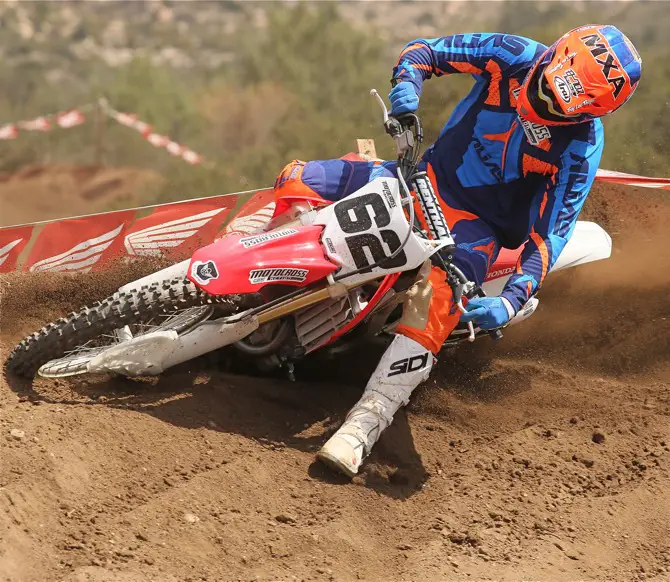
Q: FIRST AND FOREMOST, IS THE 2014 CRF450 BETTER THAN THE 2013 CRF450?
A: Yes, but barely. Since the 2013 Honda CRF450 was a totally new model, save for the engine, it was unlikely that Honda would spend a lot of R&D cash on reworking the new design for 2014. But, Honda did focus their small R&D budget on improving some areas of concern. So, while the 2014 CRF450 isn’t new by any means, it is incrementally improved.
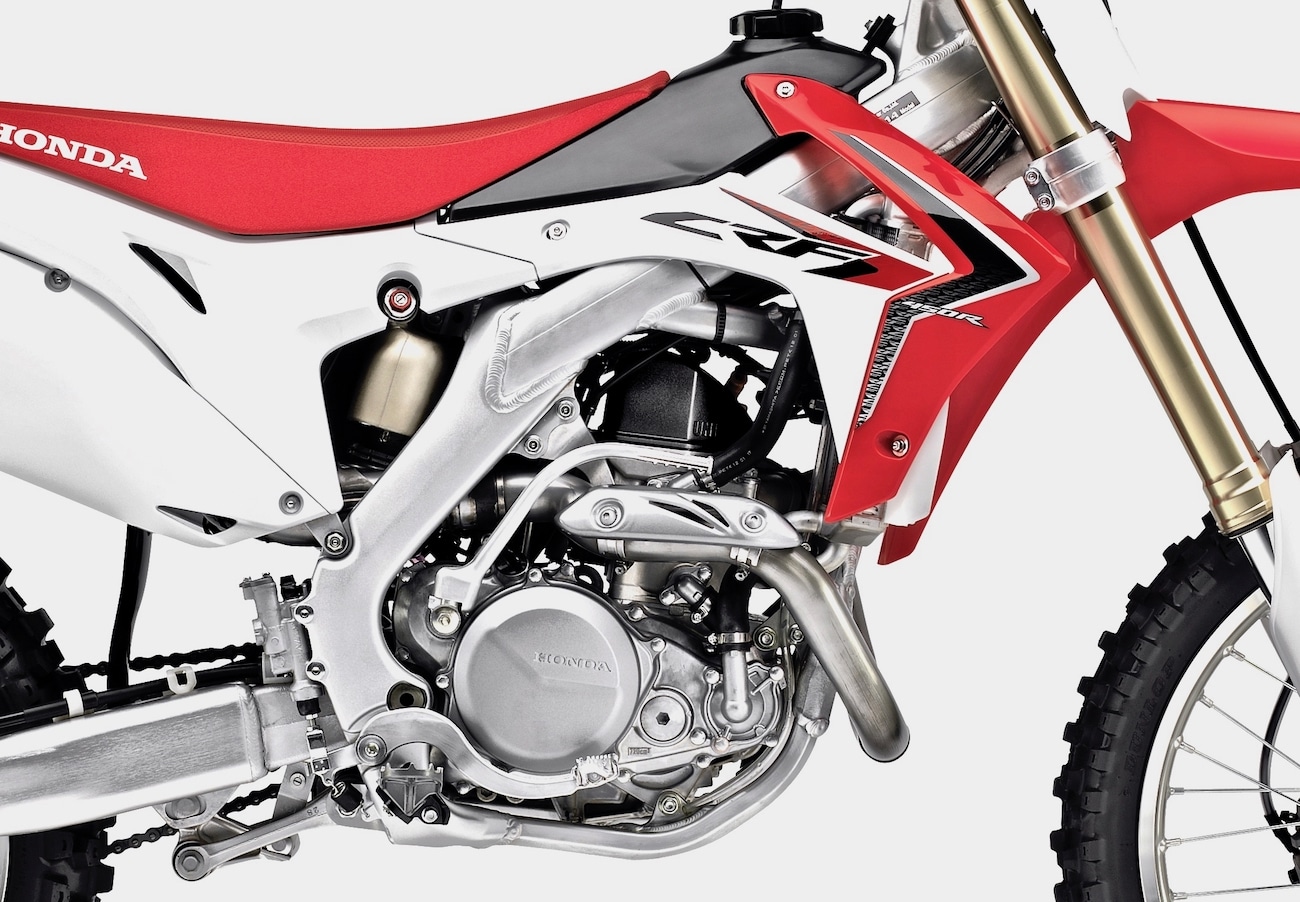
Q: WHAT DID HONDA CHANGE ON THE 2014 CRF450 ENGINE?
A: The 2014 engine looks identical to the 2009, 2010, 2011, 2012, and 2013 engines, and, for the most part, it is. It did, however, undergo six changes.
(1) Intake/exhaust ports. Both the intake and exhaust port shapes have been changed. The exhaust port splitter has been extended 10mm to divide the exhaust-gas flow more thoroughly, while the intake tract is now 3mm narrower to increase fuel velocity.
(2) Injector nozzle angle. Using a trick learned from the race team and CRF450 privateers ,who have been twisting the angle of the injector nozzle for years, the 2014 nozzle has been aimed at the center of the intake port.
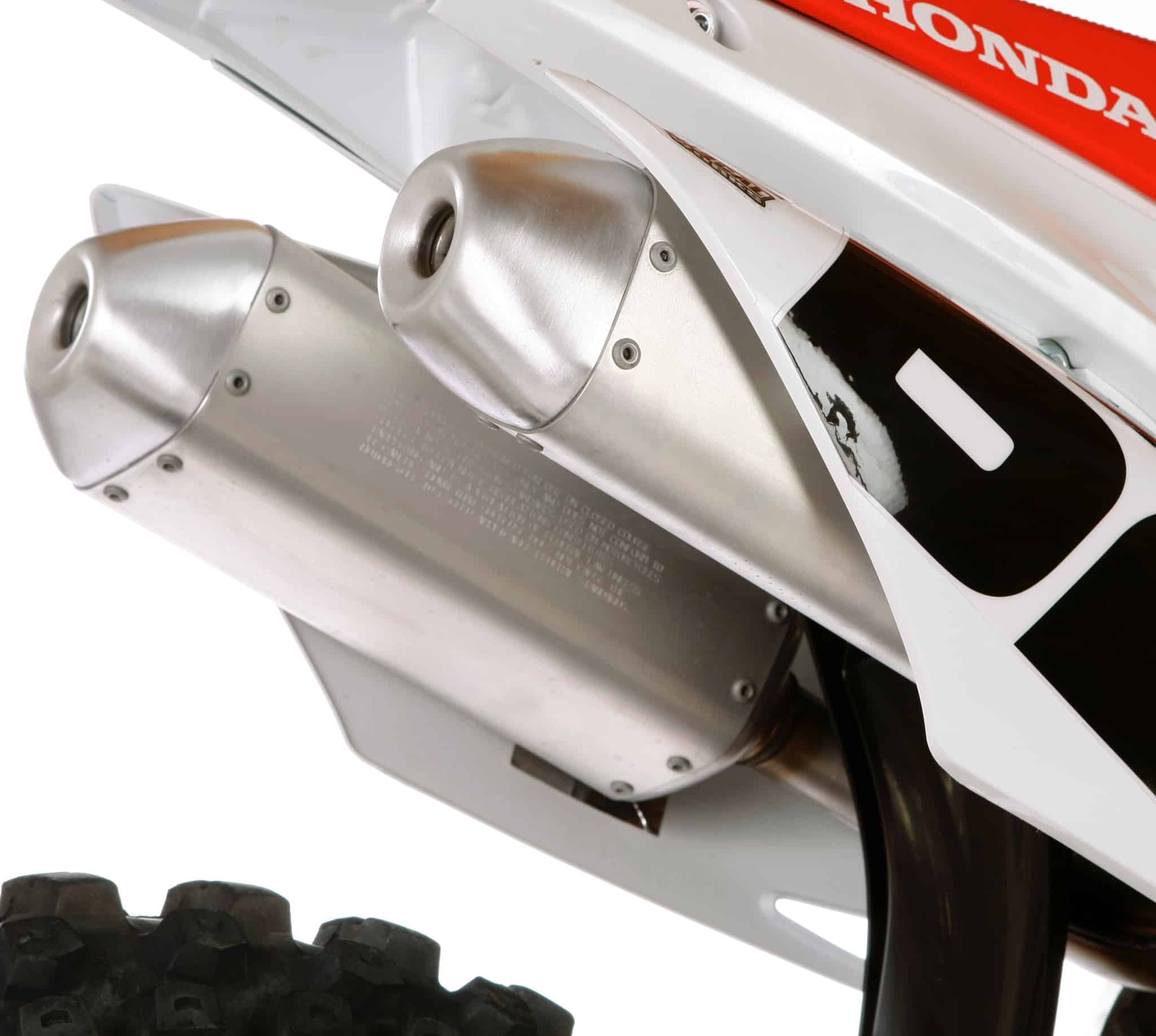 Honda must love redundancy, because two pipes is too much.
Honda must love redundancy, because two pipes is too much.
(3) Exhaust Y-splitter. At the Y-junction of the twin exhaust, the size of the exhaust pipes has been reconfigured to ensure equal exhaust flow down both sides of the “twice pipes.” To achieve this, Honda moved the Y-splitter, which redirects the flow from the single head pipe to the twin mid-pipes, 6mm to the outside. Visually, this makes it look like the left-side pipe is larger than the right-side pipe, but in reality, it balances out the flow. Additionally, the muffler core and end-cap diameter have been increased from 18.5mm to 22mm.
(4) Black valve cover. In 2013, the valve cover was silver. In 2014, it is black.
(5) Dual-Timing EFI. The biggest technical change is that Honda incorporated a dual-fuel delivery system via the 12-port injector nozzle.
(6) Mapping. Because of the new Dual-Timing fuel injection’s complexity, the 2014 mapping has been reconfigured to use the engine’s rpm and throttle position to time the flow of fuel. Unfortunately, the Throttle Position Sensor (TPS) on our test bike failed.
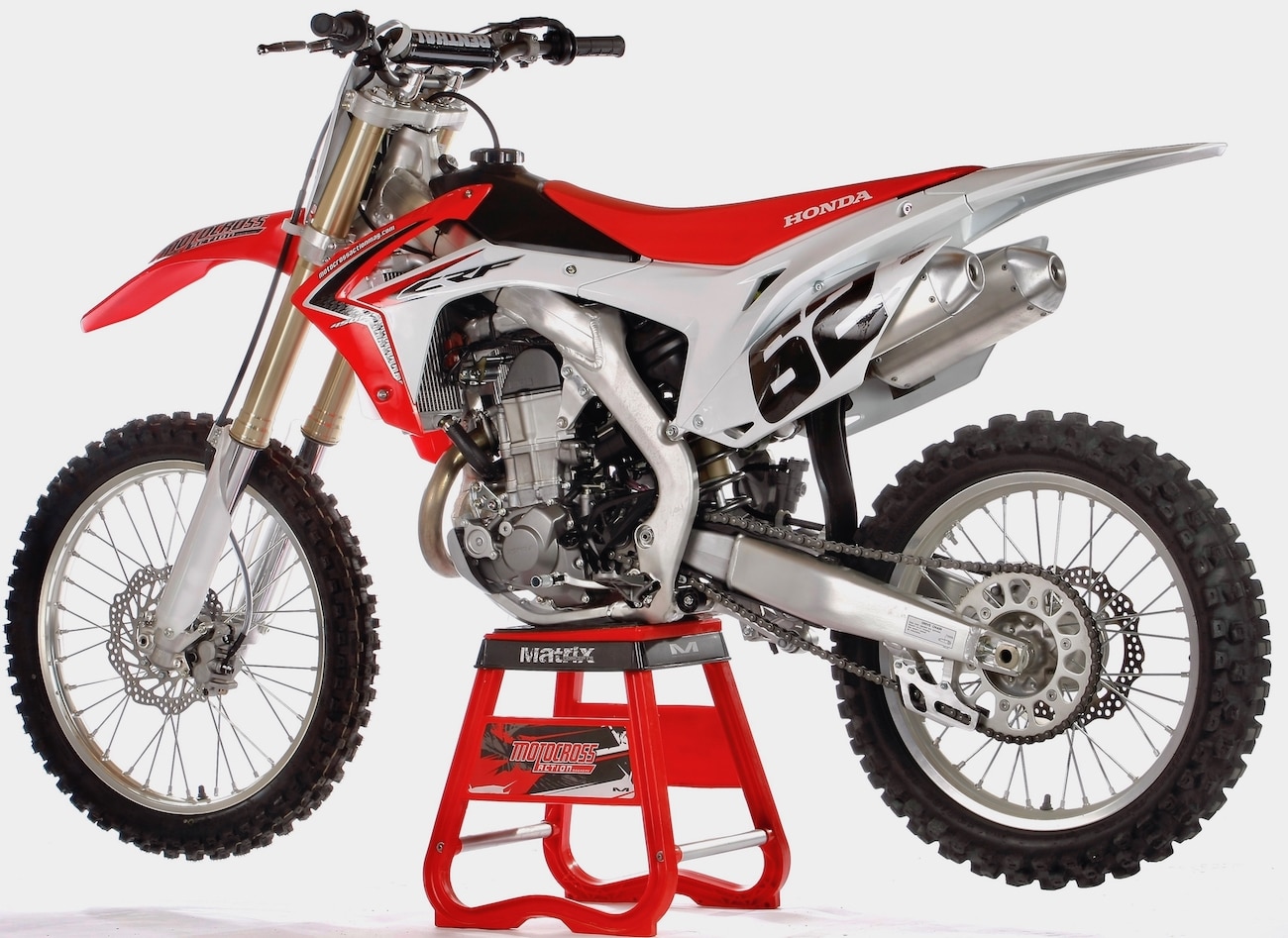
Q: IS HONDA’S DUAL-TIMING FUEL INJECTION IDENTICAL TO KAWASAKI’S DUAL-FUEL INJECTION?
A: No. Not even close. They are completely different.
Kawasaki’s Dual-Fuel injection. Dual-Fuel injection was introduced in 2012 on the KX250F. It wasn’t new technology, as both Honda and Kawasaki had used it before on their street bikes. Dual-Fuel incorporates two fuel-injector nozzles instead of one. The primary injector is in the standard location in the throttle body, while the secondary fuel injector is mounted remotely in the air boot. The primary injector delivers fuel from idle to 7000 rpm, then the secondary injector delivers fuel from 7000 rpm up through 13,000 rpm. Kawasaki’s Dual-Fuel doesn’t benefit as much from having two injectors as you would think, because in function only one injector works at any given time. The big plus of dual injectors is the different column lengths of the fuel stream at low and high rpm.
Honda’s Dual-Timing injection. The Honda system does not use two injector nozzles, nor does it meter the amount of fuel between separate systems. Instead, Honda’s Dual-Timing separates the spray from its single injector into two charges. The first charge is a short-duration spray that is used to cool the back of the intake valve’s heads. The first charge is followed immediately by a second charge that lasts longer and provides the majority of operating fuel. The key element of Honda’s Dual-Timing concept is that the first burst of fuel cools the intake port and valve head down enough to increase the density of the air/fuel mixture for the second fuel burst. Cooling the surface of the intake port means more oxygen in the fuel mixture. Don’t think of Honda’s Dual-Timing fuel injection as two separate bursts of fuel. It is really one long spray of fuel with a pause in it at the very beginning.

Q: WHAT ELSE IS NEW ON THE 2014 HONDA CRF450?
A: Hardly anything. The only other mod is that the Kayaba PSF fork gets new valving, a one-piece rebound piston (it was a two-piece unit in 2013), slightly lower oil height, and a recommended increase in air pressure from 33 psi to 35 psi.
Q: HOW FAST IS THE 2014 CRF450 ON THE TRACK?
A: It’s slow and we mean slow!. We can’t dance around the elephant in the room. It doesn’t make much horsepower, and it signs off very early. It isn’t powerful, especially when compared to the 2014 Yamaha YZ450F, KTM 450SXF or Kawasaki KX450F. It gives up five or more horsepower to these three players. You don’t need Dr. Watson to tell you that when you give up that much horsepower to the competition, you will find yourself hurting on long straights, in deep sand, on big hills or in most drag-race situations. Even worse, unless you spend beaucoup bucks on hop-up exotica, you’ll only be chasing the stock horsepower of the green, orange and blue brands—never exceeding them.
 2014 Honda CRF450: How do you tell a 2014 Honda CRF450 from a 2013 model on the fly? The 2014 CRF450 engine has a black valve cover, while the 2013 had a silver cover.
2014 Honda CRF450: How do you tell a 2014 Honda CRF450 from a 2013 model on the fly? The 2014 CRF450 engine has a black valve cover, while the 2013 had a silver cover.
That said, if you are of the school of thought that 450cc motocross bikes are too powerful for mortal man, this is your bike. By focusing their attention on roll-on response, low-to-mid usability, and maximum power in the 6000 rpm to 8500 rpm range, Honda’s engineers made the CRF450 easy to ride. It is loaded with plentiful traction and quick when used right. One caveat: don’t try to rev it out. It is most competitive when kept below 8500 rpm. If you push the rpm into the upper reaches, the CRF450 slows down instead of speeding up. After 8500 rpm, the 2014 CRF450 goes flat. No high rpm thrust means that you need to shift, shift and shift again.
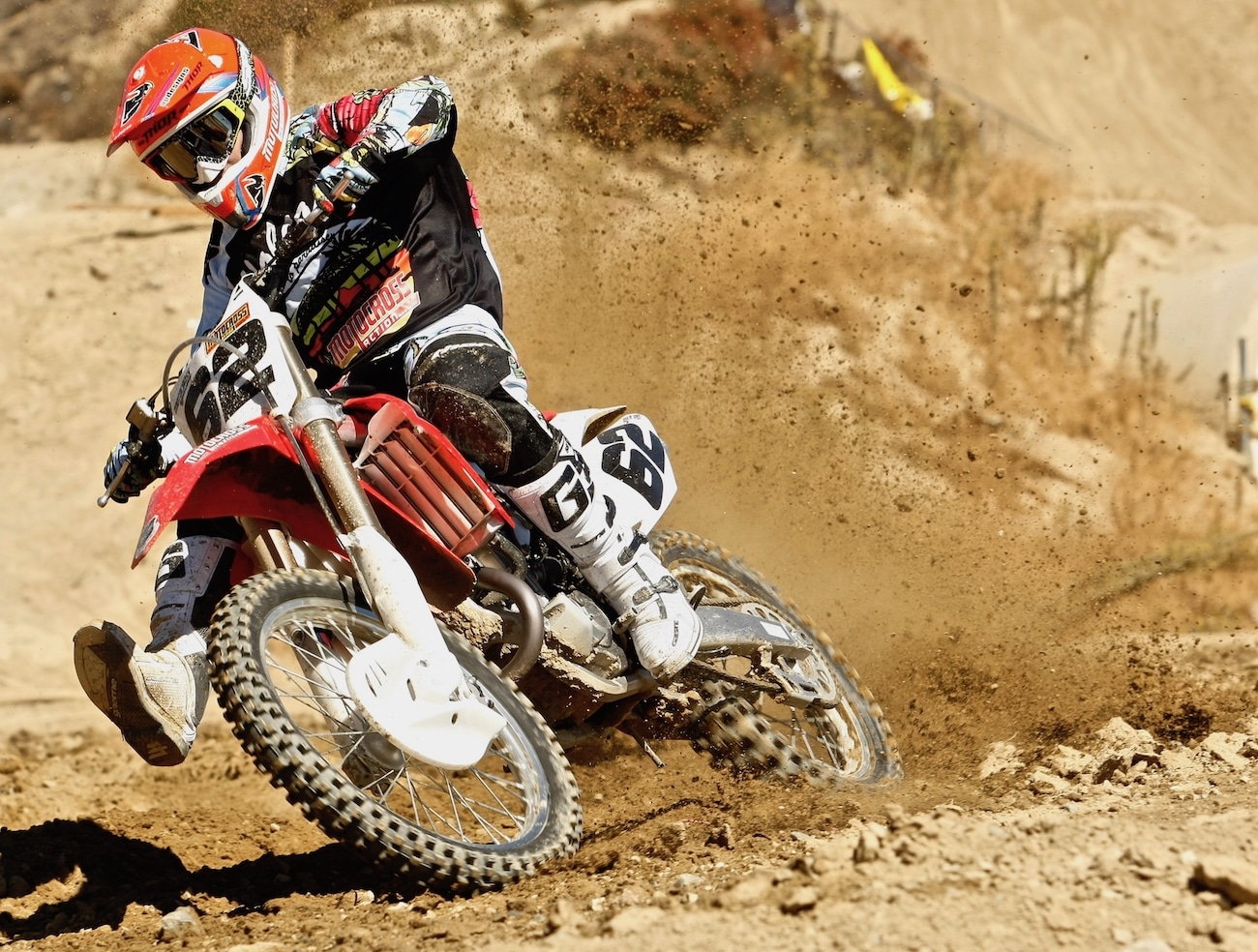
Q: WHAT’S THE BEST THING ABOUT THE 2014 CRF450 POWERBAND?
A: There is none of the rushing around like on other bikes. All kidding aside, it is the delivery. With its tractable roll-on power, moderate rev speed and torquey low-to mid transition, you can go fast on the CRF450 because you can use all it’s got. Honda’s “Slower is faster” design philosophy, means that the CRF450It can be made to go fast, even though it isn’t fast, because there are fewer white-knuckle moments.
The key to racing the 2014 Honda CRF450 is an understanding of how to make the most of the CRF450 powerband. The mellow power allows a rider to get on the gas sooner and, as long as he shifts at 8500 rpm and not one rpm later, the CRF450 can go fast. It doesn’t generate speed, but it does carry it.
Q: HOW DOES THE 2014 CRF450 RUN ON THE DYNO?
A: It is pitiful on the dyno. Peak horsepower on the 2014 Honda CRF450 is 51.97 (last year the 2013 CRF450 made 51.55 horsepower). The 2014 blue, orange, green and yellow 450s made 58.22 (YZ450F), 56.95 (KTM 450SXF), 55.05 (KX450F) and 54.10 (RM-Z450). To highlight the CRF450’s horsepower deficit, especially after the midrange, the 2014 YZ450F makes 58.22 horsepower at 9900 rpm. At that same rpm, the 2014 Honda CRF450 is only making 49.57 horsepower. That is 8.6 horsepower less.
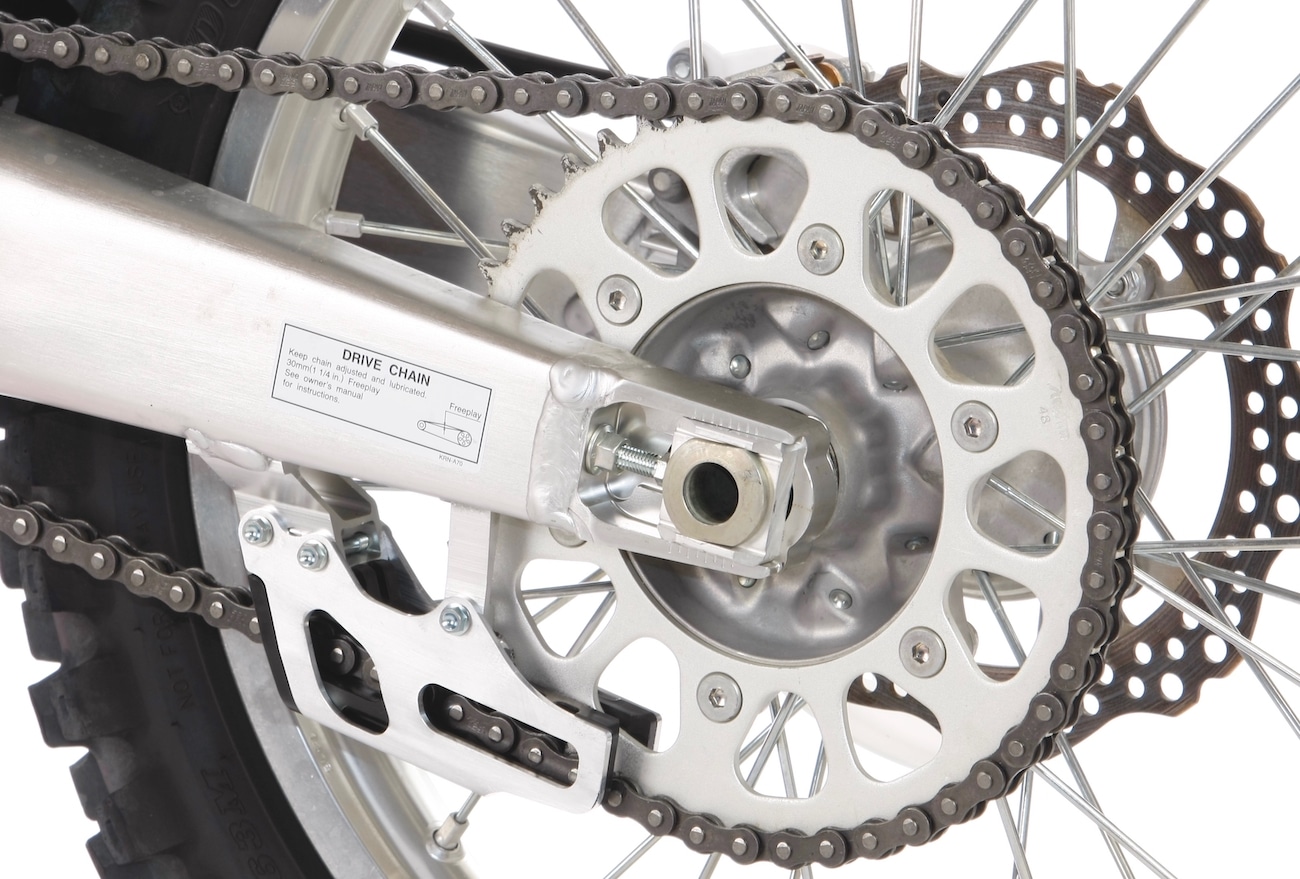
Q: WHAT DO YOU NEED TO KNOW ABOUT THE 2014 HONDA CRF450?
A: Gearing. Gear it down from 48 teeth to 49 teeth. You’ll like it a lot better.
Clutch. In 2013, Honda drop-kicked the atrocious four-spring clutch and returned to their previous six-spring clutch. It wasn’t a big improvement. The 2014 clutch has a spongy feel at the lever, and the release point is irritatingly close to the grip. To fix it, we removed the jutter spring and downsized inner plate and added a full-size clutch plate and stiffer clutch springs.
Diet conscious: Although the CRF450 has gained a couple pounds since its slim and trim days, at 236 pounds it is still the lightest 450.
Twice pipes. We don’t get it. Honda loves to talk about centralization of mass, but in the process of trying to achieve that they are adding more mass. That is like having a Diet Coke with your cheeseburger. In our experience, single-sided exhaust systems are lighter, run better, cost less and are easier to repack.
Front brake. Honda once had the best brakes in the biz, but that was a long time ago. Invest in an oversize front-brake rotor if you want this bike to stop as well as a KTM.
Flame out. This has been a Honda problem ever since they went to EFI. We solve our flame-out issues by turning the idle up a couple clicks.
PSF air valves. To make the air forks easier to adjust, we install either Splitstream cross-over tubes or Works Connection EZ Fill air valves.
Fork seals. We blew more Kayaba PSF fork seals last year between our KX450F and CRF450 than all the other bikes in our test quiver combined. In the end, we switched to SKF seals and neoprene fork skins to stop the madness.
Shock linkage. The benefits of dropping the rear of the CRF and stiffening up the initial part of the stroke with a longer link arm are undeniable. Since the longer link rotates the bell crank into a stiffer position, the longer link increases low-speed resistance and holds the rear higher in the bumps. It also lowers the rear of the bike by 1/2 inch, which allows you more leeway for sliding the forks up and down in the clamps to fine tune the head angle. Visit Pro Circuit at www.procircuit.com.
Flywheel weight. We had good luck with a Steahly 17-ounce, bolt-on flywheel weight. It smoothed out the CRF450’s bottom end, broadened the middle and gave the impression of more pull on top. Visit Steahly at www.steahlyoffroad.com.
Side panels. We replaced the four separate rear number plate pieces with DeCal Works complete side panels. Not only do they turn four pieces into two, but they are sleeker and slimmer where your legs go. Visit DeCal Works at www.decalmx.com

Q: DOES THE 2014 CRF450 HANDLE BETTER THAN THE 2013 MODEL?
A: Even though Chad Reed became the same thorn in the side of Honda that James Stewart was in the side of Yamaha, we are mystified by Chad’s love of the 2009 through 2012 chassis. Chad left Honda because he didn’t like the way the 2013 bike turned, but many consumers left Honda over the four-year span from 2009 to 2012 because they didn’t like the way those bikes turned.
We don’t agree with Chad. Turn initiation on the 2013 and 2014 Honda CRF450 is its best trait. It feels crisp, light and agile. The old model was vague, loose and twitchy. We like the 2013-2014 chassis and we really didn’t like it from 2009 to 2012. The newest generation chassis is a winner.
Q: WHAT DID WE HATE?
A: The hate list:
(1) Gearing. Lowering the 13/48 gearing to 13/49 increases the drive, tightens up the shift-to-shift spacing and improves the raceability of the CRF450. If you think that the 13/49 is too low, try a 14/52 combo. It is lower than the stock 3.69 gear ratio at 3.71, but not as low as the 13/49’s 3.77. We think most Novices and Vets benefit from the lowest gearing, while Pros and Intermediates can carry the 14/52 combo.
(2) Brakes. Hard to believe that these were once considered the industry’s best brakes. Now, in light of KTM’s awesome Brembo units, the Honda brakes are average at best. Toss the front disc guard if you race long motos to help cool the rotors and pads.
(3) Twice pipes. Motocross bikes should be minimalist, simple and easy to work on. Twice of any part is too much.
(4) Power. It gives up too much horsepower to the YZ450F, KX450 and 450SXF. You’d have to use a golden shovel to dig your way out of this horsepower hole.
(5) Throttle Position Sensor. Our TPS unit fritzed out and left us stranded and waiting for a part.
Q: WHAT DID WE LIKE?
A: The like list:
(1) Setup. In motion, the Honda feels light, graceful and agile. It is fun to ride.
Q: WHAT DO WE REALLY THINK?
A: The 2014 Honda CRF450 is the 2013 model with a black valve cover. Yes, Honda did add Dual-Timing EFI to help the anemic powerband, but that’s like using a Dixie cup to bail out the Titanic. Forget about the engine, this bike is all about feel.
2014 HONDA CRF450 SETUP SPECS
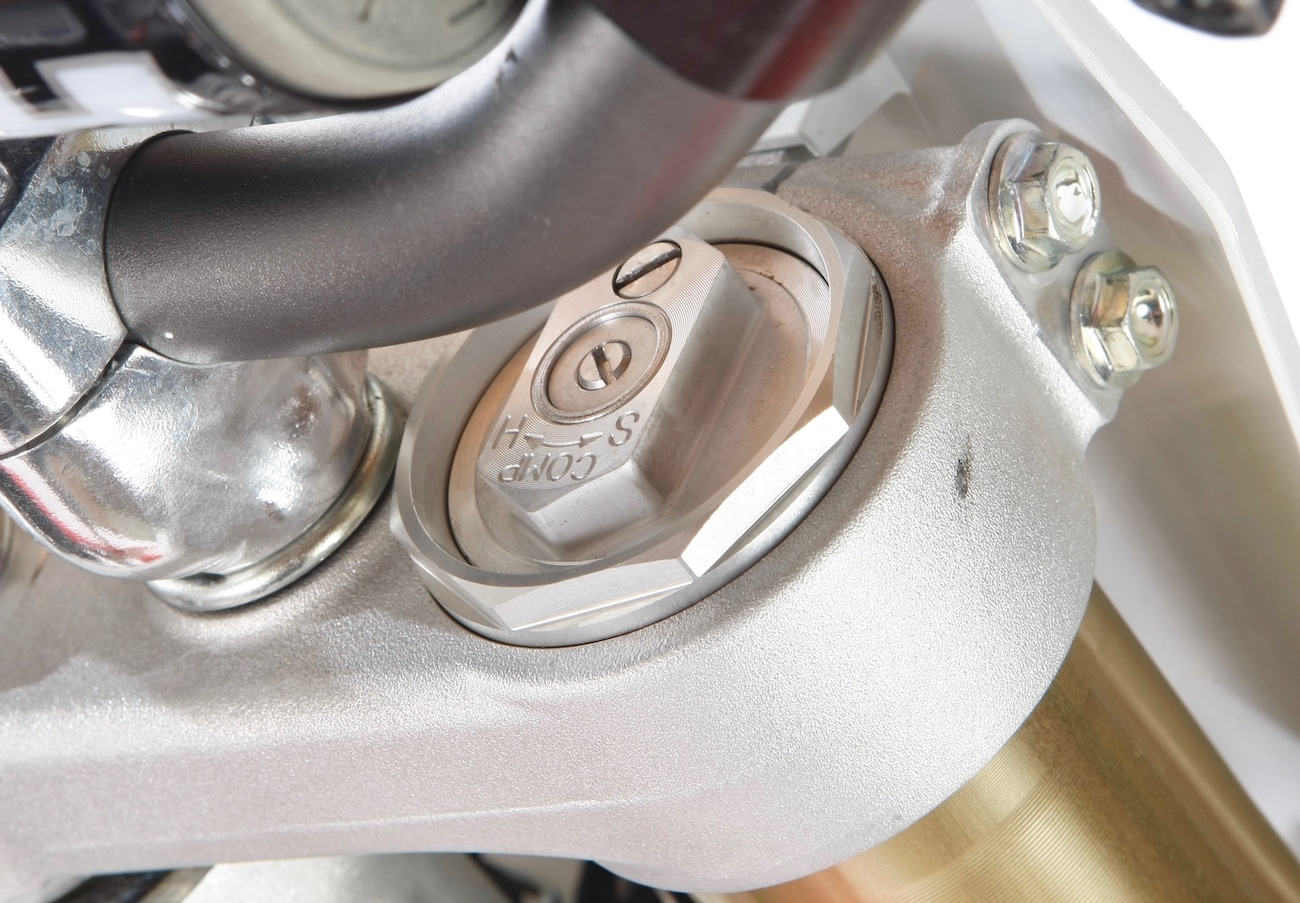 Air force: You have to check the air pressure every day and keep a close eye on the fork seals because they tend to wear out quickly.
Air force: You have to check the air pressure every day and keep a close eye on the fork seals because they tend to wear out quickly.
KAYABA PSF FORK SETTINGS
Last year MXA suggested 35 pounds of air pressure instead of Honda’s recommended 33 psi. So, we aren’t surprised that Honda has changed their air pressure spec for 2014. But, don’t get too enamored with the air pressure. The air replaces the steel coil springs, and once you find the correct number for your weight, speed and track, you should live with it. Then, use the clicker settings and oil height to make adjustments. The pluses of air forks are infinite adjustment and light weight. The downsides are that they require constant attention. When they work properly they are good forks, but the air pressure is constantly changing, so perfection is at best temporary (as is the life of the fork seals).
For hardcore racing, these are MXA’s recommended 2014 Honda CRF450 fork settings (stock settings are in parentheses):
Spring rate: 35 psi
Oil height: 242cc
Compression: 11 clicks out (13 clicks out)
Rebound: 10 clicks out
Fork-leg height: 5mm up
Notes: Theoretically, going up 2 psi is the equivalent of going up one spring rate (from 0.47 to 0.48). That means that the 2014 forks, when set to Honda’s specs, are one spring rate stiffer than in 2013. The higher the pressure, the greater the ramp-up effect, which is why Honda lowered the fork-oil height from 245cc to 242cc.
KAYABA SHOCK SETTINGS
Most MXA test riders had issues with the 5.5 kg/mm shock spring. It is not stiff enough for fast or heavy riders. When a spring rate is too light, riders crank in excessive preload, which causes the shock to kick in braking bumps. We went to a stiffer 5.7 kg/mm shock spring, which lessened the preload and helped balance out the chassis. Riders under 160 pounds or less than Expert speed can stick with the stock spring. If you feel you are on the cusp of needing a stiffer shock spring, installing the longer shock linkage could give you the extra damping assistance you need to stay with the stock 5.5 spring
For hardcore racing, these are MXA’s recommended 2014 CRF450 shock settings (stock settings are in parentheses).
Spring rate: 5.7 kg/mm (5.5 kg/mm)
Race sag: 100mm
Hi-compression: 2 turns out (1-5/8 out)
Lo-compression: 12 clicks out (14 out)
Rebound: 8 clicks out
Notes: Selecting the proper spring rate is important for the overall feel of the chassis and to lessen kicking. Although we went one spring rate stiffer, several test riders wanted to go two spring rates stiffer. As a rule of thumb, use free sag to determine whether the spring is stiff enough (try to get 30 to 40mm of unladened sag).







Comments are closed.